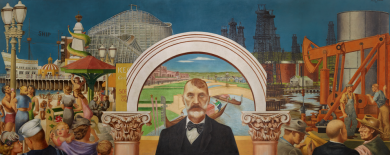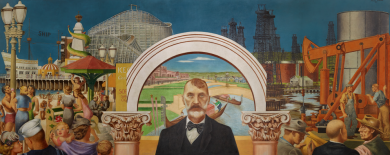It all started late last November. That is, the idea for Edward Biberman’s Venice, California, Post Office mural, Abbot Kinney and the Story of Venice, to be shown at LACMA. The e-mail I received was short: it just read that my boss, Michael Govan, LACMA’s CEO and Wallis Annenberg Director, had a new project for me. I was working at home, deeply involved in trying to finish an essay about the large fountain sculpture the museum commissioned Alexander Calder to do to mark its opening in 1965. I was steeped in mid-century fountain technology, so I was not thrilled to have my attention transferred to another project. But that is the life of a curator—we have to be able to multitask and be able to jump from one time period to another.
I knew that the United States Postal Service had sold the Venice post office building to Hollywood producer Joel Silver and had arranged for Mr. Silver to have the enormous mural conserved and then become its caretaker. I was aware of these developments because New Deal murals are one of my hobbies—I once was the director of a mural survey for the City of New York and also did similar work for the City of Santa Monica—and I also had done a great deal of research on the artist Biberman and his famous family. We both hail from Philadelphia, so I felt a tie. Anyway, what I was not aware of was the ongoing discussions between Silver and Govan about exhibiting the amusing mural here in the American art galleries before it was returned to the Venice, California, building.
 Edward Biberman, Abbot Kinney and the Story of Venice, lent by the United States Postal Service®, recent conservation provided by Joel Silver, photo by Anthony Peres © 2014
Edward Biberman, Abbot Kinney and the Story of Venice, lent by the United States Postal Service®, recent conservation provided by Joel Silver, photo by Anthony Peres © 2014
I refer to the mural affectionately as “amusing” because Biberman’s quirky approach to its subject differed substantially from most of the post office murals that were sponsored by the Treasury Section project of the New Deal, from 1934 to 1943 (Biberman’s dates from 1941). Artists who won the commissions, after submitting designs in a competition, were encouraged to relate the mural subject matter to the geographical region in which it would be displayed. So artists often chose a local historical event. Biberman captured in three scenes the utopian vision of Venice’s founder, Abbot Kinney, to create a suburban neighborhood based on the canals of Venice, Italy. The other two scenes demonstrate the less-than idyllic outcome, with all realistically portrayed in bright colors.
I decided if we were to install the mural, it needed some context. So I had my new research assistant start to investigate the New Deal projects in Southern California as well as the development of Venice. The story is quite fascinating. (Stay tuned to Unframed for more about the history as presented in this special installation). We hope families will come to learn about their neighboring beach community of Venice.
Ilene Susan Fort, Senior Curator and John and Gail Liebes Curator of American Art



